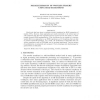Free Online Productivity Tools
i2Speak
i2Symbol
i2OCR
iTex2Img
iWeb2Print
iWeb2Shot
i2Type
iPdf2Split
iPdf2Merge
i2Bopomofo
i2Arabic
i2Style
i2Image
i2PDF
iLatex2Rtf
Sci2ools
84
Voted
PPL
2006
2006
Parallelization of Wavelet Filters Using Simd Extensions
Much work has been done to optimize wavelet transforms for SIMD extensions of modern CPUs. However, these approaches are mostly restricted to the vertical part of 2-D transforms with line-wise organized memory layouts because this leads to a rather straight forward SIMD-implementation. This work shows for an example of a common wavelet filter new approaches to use SIMD operations on 1-D transforms that are able to produce reasonable speedups. As a result, the performance of algorithms that use wavelet transforms, such as JPEG2000, can be increased significantly. Various variants of parallelization are presented and compared. Their advantages and disadvantages for general filters are discussed.
Related Content
| Added | 14 Dec 2010 |
| Updated | 14 Dec 2010 |
| Type | Journal |
| Year | 2006 |
| Where | PPL |
| Authors | Rade Kutil, Peter Eder |
Comments (0)

